Aiptek PocketCinema V100 Pico Projector Review: 120 inches for $ 415
Not so long ago, I got two Aiptek picoprojectors. The Aiptek PocketCinema V60 model has already undergone a detailed review and, after some hesitation, has taken the permanent place of a home device. The next step is the purchase of HDMI-stick on Android, whose review, by the way, will also be published soon. However, I was distracted, now it is the turn of Aiptek PocketCinema V100, which is quite actively sold in Russia. For me, this is somewhat surprising, because it would seem more sensible to bet on a more budget Aiptek PocketCinema V60 with a meager number of competitors. Anyway, I still do not see the V60 version on sale, unlike the older V100 model.
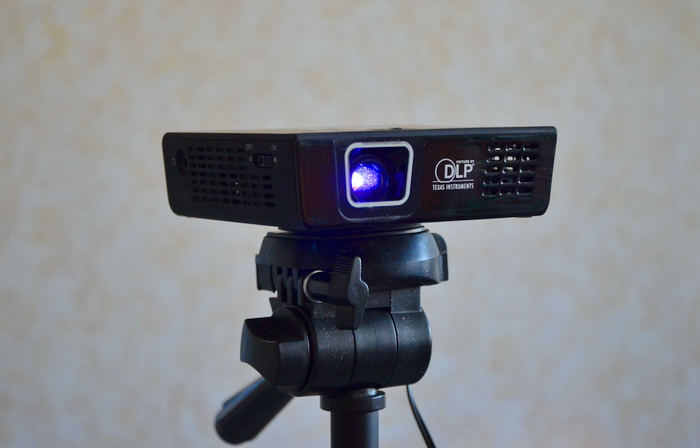
Let me remind you, Aiptek PocketCinema V60 is estimated at about $ 320. Price list version V100, as it relies on Yandek.Market, accompanied by a noticeable variation. The lower limit starts from 13,290 rubles (about $ 415), the seller carries the device to order and even allows you not to spend money on the courier - self-service "taxis". The upper bar rests on almost 18,500 rubles, which looks like a somewhat inadequate query. We will talk about competitors in the output, but for now we take the box in our hands and begin to study the picoprojector.
')
Contents of delivery
The Aiptek PocketCinema V100 box is framed in soothing shades of blue, which contrasts sharply with the more “screaming” packs of smartphones and tablets that I am used to. Set out the main "chips" and characteristics - more and we do not need. Interestingly, among the possible to connect devices, BlackBerry smartphones are listed separately.
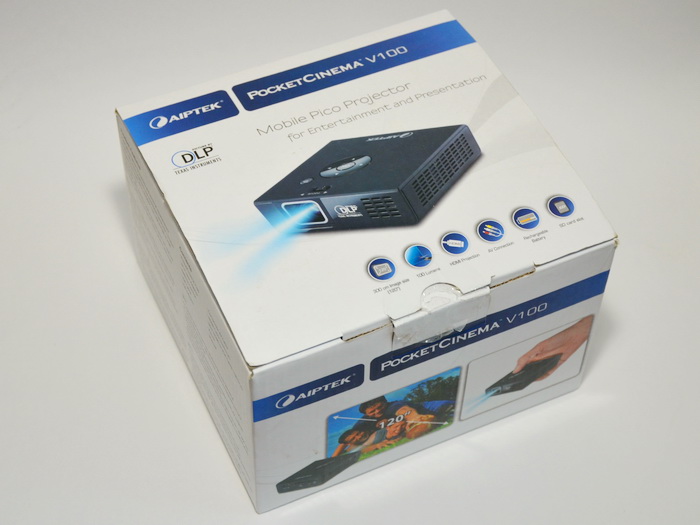
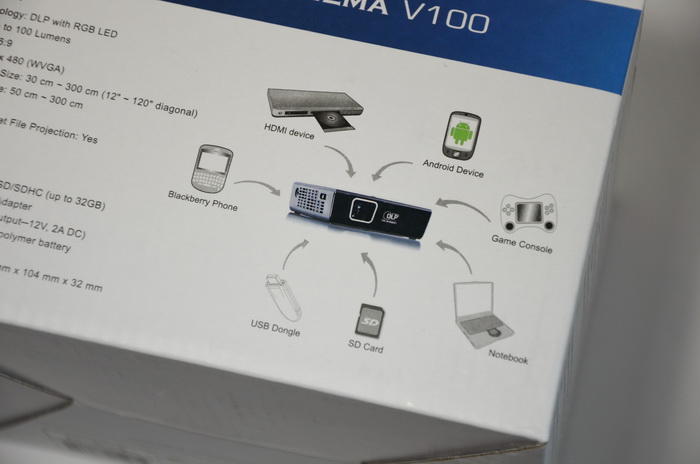
It is commendable that the developers did not guess which region which box would fall into, three interchangeable plug options are included in the kit. This can be especially useful when traveling, when on vacation in a hotel you want to watch a movie and not “steam” about compatibility with the outlet.
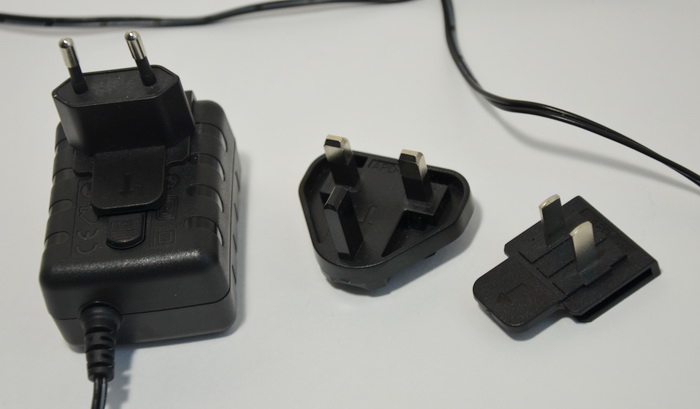
Plenty of cables, we have OTG-lace, AV-cable, miniUSB and HDMI-miniHDMI. Immediately a bit of criticism - the AV wire turned out to be breathtakingly short. I suspect that this may be the reason for the lack of a real opportunity to use the cable where I would like to do it. Further - in my opinion, it would be better to make an HDMI connector in the projector, rather than miniHDMI. In the first case, the probability of having a long wire at home is much higher. Let me remind you that the length of the HDMI-HDMI cable did not satisfy me in Aiptek PocketCinema V60, and equally in V100. In addition, in case of damage, finding a miniHDMI wire may not be the easiest venture. However, despite the not very pleasant paragraph for the projector, the above can be considered my personal quibbles.

Let's move on to the "pieces of paper". In the presence of a detailed manul, including explanations in Russian. A warranty book is attached, in which nothing Russian-speaking is given. But there was a “native” insert, in which I was still being convinced that there was at least some problem in the device.

The complete case came out ambiguous. It is good that in principle it is - it is critical for a device that implies a regular stay “on the road”. On the other hand, it is absolutely incomprehensible to me what the “ventilation” on the sides is for. But I welcome some "dutost" of the cover, in such a situation it is not terrible to drop the projector from a small height.

The subsection ends with a remote, oddly enough, turned out to be less functional in comparison with the Aiptek PocketCinema V60. Good or bad, let everyone decide individually.
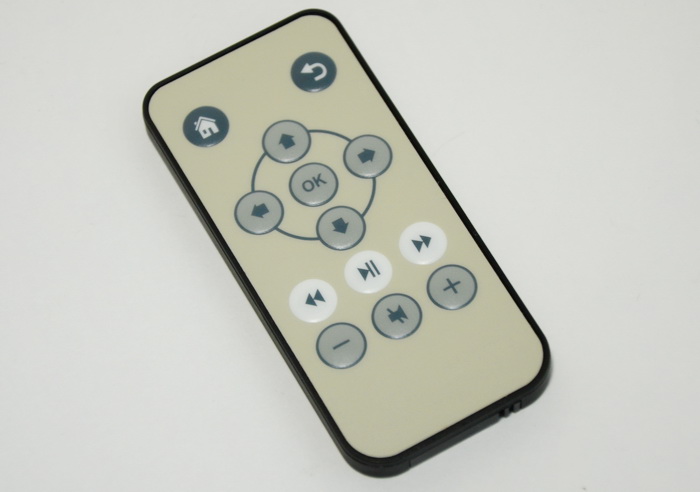
Appearance, connectors and controls
The first thing that catches your eye is that the case is almost completely finished “under” soft-plastic. I can positively note this moment, all sorts of traces of exploitation on the projector really almost do not remain. The device turned out relatively heavy and weighs 300 grams. In this case, this is a definite plus, since, together with the sturdy rubber feet, the projector cannot be moved by accidental contact. By the way, for the same reason, unlike Aiptek PocketCinema V60, the buttons here are not sensory, but “completely” physical. And by pressing them we do not risk shifting the apparatus.
Dimensions are 106 x 104 x 32 mm. Just in case - on Yandex.Market in the description of the model and size, and the weight is incorrect. So, against the background of the younger model, the projector looks bigger, you can hardly put it in the inside pocket of your jacket. Nevertheless, it is still quite a compact projector with the prefix "pico".
The front side panel is the only glossy case element. We note the "broadcast eye" and slots for air exhaust.

The right side is entirely given under the ventilation.
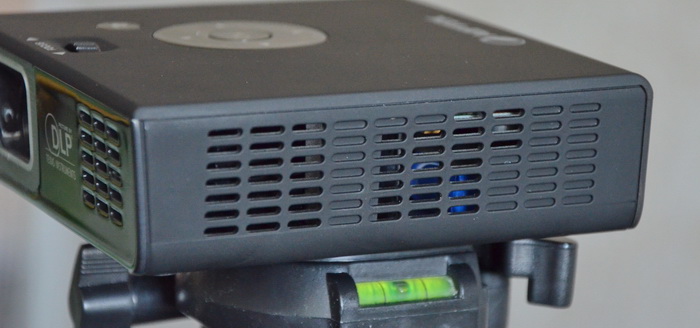
On the left is the power switch and a 3.5 mm jack for connecting an external audio system.

As well as believes to a projector, the main part of connectors and slots is behind. From left to right - DC, miniUSB input, IR remote receiver, SD slot, AV input and miniHDMI connector with YPbPr subscription. I have already said about miniHDMI, I also note that the slot for SD-cards is not very relevant for me. Although if someone is going to often take pictures taken on the camera, the Aiptek PocketCinema V100 will look more versatile against the background of the V60.
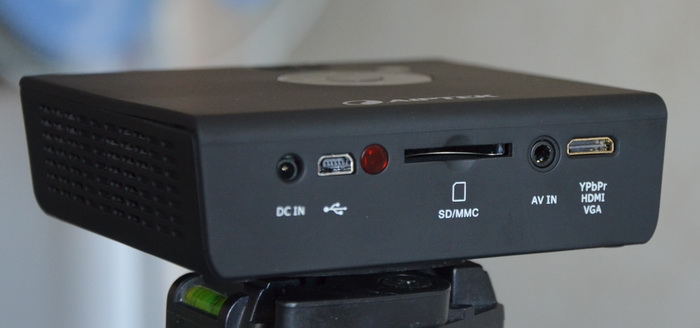
Above are the return key, a round joystick with a central confirmation button and a focus wheel. The latter was initially unpleasantly surprised by some emphasis and “unwinding” of the set value. But over time, the problem disappeared.

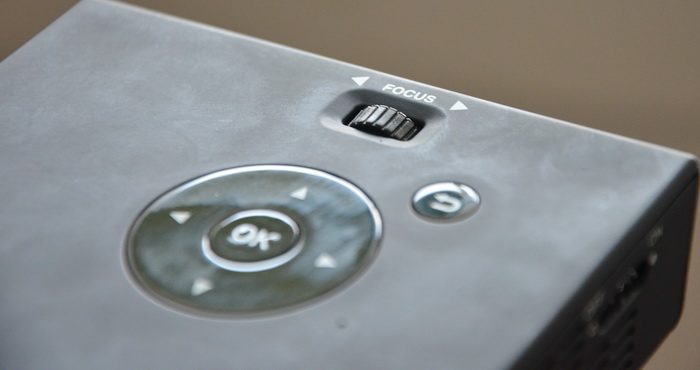
In work
2 GB of internal memory is always “with us”, so even without memory cards and a computer, the projector will fit perfectly for storing a microscopic multimedia collection. However, I will not exaggerate - this volume is more than enough for storing the presentation materials of some sales manager.

Given that I have something to compare with (how many times have I mentioned the V60?), I’ll present the “starting” impressions of the projector. First, the device works very quietly. The usual human speech easily overlaps a quiet hum, not to mention the “muffling” sound from the internal speaker or connected speakers. Secondly, the commands are executed very quickly, without any delays. A good brightness and image clarity is striking - but more on that later.
Go through the system menu. On the main screen, in-line access to video, music, photos, a common file manager, the choice of signal source and settings are lined up.
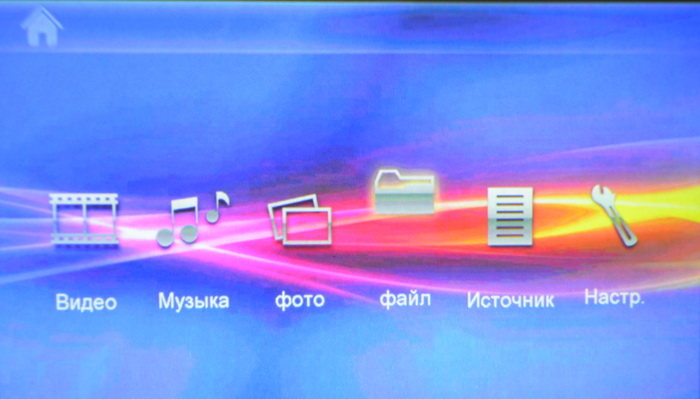
I note that in the source selection menu at the same time there is the installation of the projector as a mobile outlet - you can charge tablets or smartphones from the device. 1,800 mAh is enough to charge some kind of flagship smartphone for eighty percent.
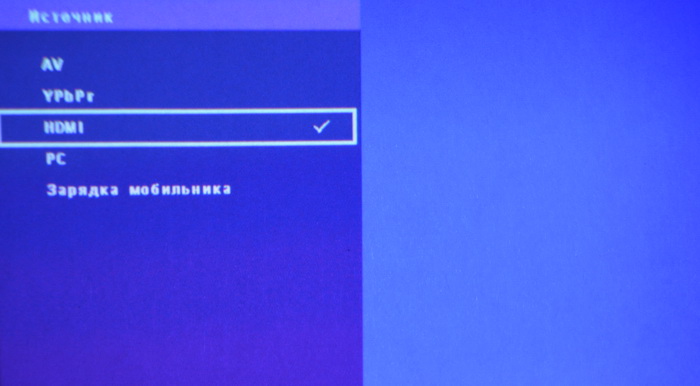
In the settings, all items fit on one screen, which was not possible for Aiptek PocketCinema V60.
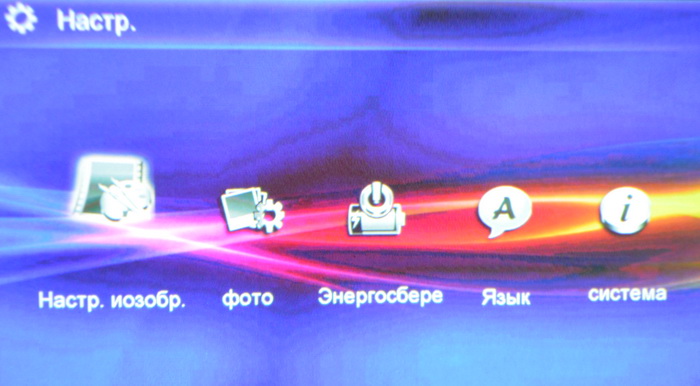
Image setting. Intelligent tuning (manual, standard, bright, soft), brightness (0-10), contrast (0-10), saturation (0-10), design mode (normal, inverted and something like mirror reflection).

A photo. Messages (output in the form of a list or icons), time per image (2-20 seconds), the order of the slide show (standard, in random order).
Energy saving. ECO mode (on / off), music screen (on / off), sleep mode (on / off).
Tongue. Choose among 16 options.
System. Reset settings, firmware update, information (firmware version, amount of free internal memory).
As you can see, there are more settings in comparison with the V60, while nothing superfluous is observed. Is that too picky comrades have to tinker with adjusting the image - there is something to experiment.
Immediately about autonomous work - 90 minutes of playback are announced, depending on the picture settings and the sound source, this is quite a real indicator. It is clear that with minimal brightness and, preferably, the lack of sound at all. In my case, the lack of compromise the projector "puffed" for 50-60 minutes.
Picture
In the characteristics we see DLP optics, a 1000: 1 contrast ratio, a resolution of 854 x 480 pixels (WVGA) and brightness up to 100 lm. the size of the projected image is 12-120 inches (30-300 cm), distance 19-118 inches (50-300 cm). Frankly, a serious increase in the clarity of the picture on the background of the V60 is not noticeable, but it has made itself felt more ample opportunity to adjust the image settings. Brightness is not to say that you can watch the video without any problems during the day. In fact, the maximum values seemed to “whitewash” the picture, and did not improve its visibility. However, in the daytime all the same image was more “watchable” after the V60. As a source of the image, I also tested the iconBIT NETTAB SKAT RX tablet, which showed a picture without any ripples and interference - unlike my “permanent” 10-inch tablet. A detailed review of the tablet was written by comrade tozx, I strongly recommend that you familiarize yourself - the thing turned out to be very, very interesting in terms of alternatives to iPad mini.
View content
Declared support ... In general, nothing was stated in the instructions or on the box, I had to visit the Aiptek website. No data was also found there, if I hadn’t looked into the “Documentation” section and downloaded the “Codec Support List” file. For such a quest - definitely reprimand Aiptek. For the most detailed table - tightly shake your hand. Even supported subtitles indicated. I give a screen of the extracted PDF-document.
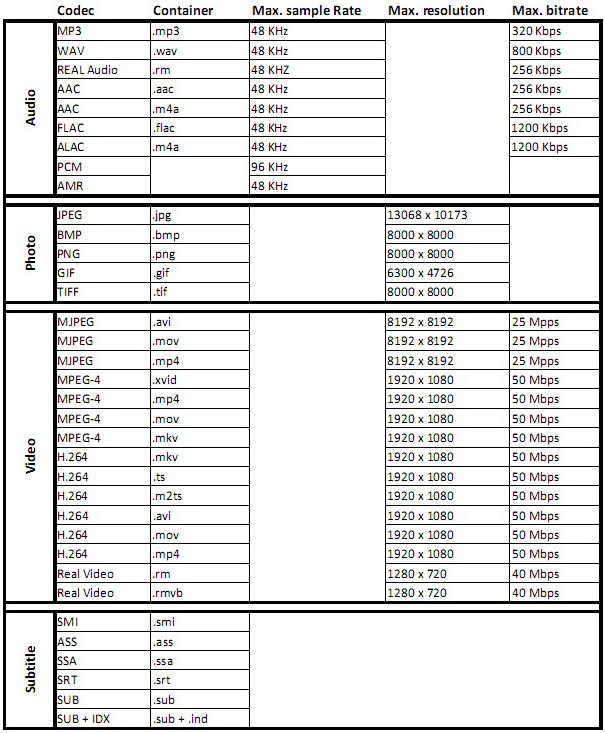
I didn’t reinvent the wheel because I threw in videos from the IXBT testing methodology:
watch-1920x1080-60p.mp4 - normal
watch-1920x1080-50p.mp4 - normal
watch-1920x1080-30p.mp4 - excellent
watch-1920x1080-25p.mp4 - excellent
watch-1920x1080-24p.mp4 - cannot be played
watch-1280x720-60p.mp4 - not playing
watch-1280x720-50p.mp4 - not playable
watch-1280x720-30p.mp4 - excellent
watch-1280x720-25p.mp4 - excellent
watch-1280x720-24p.mp4 - excellent
The results are almost identical to those in the V60, although the latter did cope with the test videos a little better. Of course, random selection of HD and Full HD clips was tested - all the material was reproduced without problems.
Here I wanted to move on to how the projector can work with Microsoft Office files, but ... As it turned out, the projector is not able to recognize other content at all, except for photos, videos and music. To put it mildly, an extremely strange decision. After all, surely the question is resolved software. In general, if you evaluate Aiptek PocketCinema V100 as a purely home device, I would not consider the disadvantages revealed. As a mobile point of presentation, alas, the projector is absolutely not suitable. As an option, if I understand correctly, the "office flaw" can correct just the purchase.
Conclusion
Not a bad decision for those who for some reason decided to buy a projector instead of a TV. In the end, buy a 120-inch TV for $ 400 remains a pipe dream. I have no special questions about working with multimedia - the files are played, the speaker of the projector is quite a loud sound, the picture does not cause complaints (with permission). In addition, the lamp life at 20,000 hours and the possibility of using for recharging mobile devices are pleasing.
Minus - perhaps not everyone will consider the price of the projector sufficient to abandon the TV - many still will report a certain amount to the cherished purchase. Also seriously enough, the potential consumer audience is limited by the complete lack of support for any document formats.
I looked at the model's competitors in price parameters of 13-14 thousand rubles, a resolution of 854 x 480 or 1024 x 768 pixels, the presence of an HDMI connector and a luminous flux of 100 lm. In the list - only two competitors, Viewsonic PJD6223 and Optoma DX329. Both do not see the slots for memory cards, but the contrast is 4,000: 1 and the brightness of 2,600-2,700 lm is impressive. Grieves up to 6,000 hours. Perhaps I will leave you the opportunity to independently draw final conclusions.

Let me remind you, Aiptek PocketCinema V60 is estimated at about $ 320. Price list version V100, as it relies on Yandek.Market, accompanied by a noticeable variation. The lower limit starts from 13,290 rubles (about $ 415), the seller carries the device to order and even allows you not to spend money on the courier - self-service "taxis". The upper bar rests on almost 18,500 rubles, which looks like a somewhat inadequate query. We will talk about competitors in the output, but for now we take the box in our hands and begin to study the picoprojector.
')
Contents of delivery
The Aiptek PocketCinema V100 box is framed in soothing shades of blue, which contrasts sharply with the more “screaming” packs of smartphones and tablets that I am used to. Set out the main "chips" and characteristics - more and we do not need. Interestingly, among the possible to connect devices, BlackBerry smartphones are listed separately.


It is commendable that the developers did not guess which region which box would fall into, three interchangeable plug options are included in the kit. This can be especially useful when traveling, when on vacation in a hotel you want to watch a movie and not “steam” about compatibility with the outlet.

Plenty of cables, we have OTG-lace, AV-cable, miniUSB and HDMI-miniHDMI. Immediately a bit of criticism - the AV wire turned out to be breathtakingly short. I suspect that this may be the reason for the lack of a real opportunity to use the cable where I would like to do it. Further - in my opinion, it would be better to make an HDMI connector in the projector, rather than miniHDMI. In the first case, the probability of having a long wire at home is much higher. Let me remind you that the length of the HDMI-HDMI cable did not satisfy me in Aiptek PocketCinema V60, and equally in V100. In addition, in case of damage, finding a miniHDMI wire may not be the easiest venture. However, despite the not very pleasant paragraph for the projector, the above can be considered my personal quibbles.

Let's move on to the "pieces of paper". In the presence of a detailed manul, including explanations in Russian. A warranty book is attached, in which nothing Russian-speaking is given. But there was a “native” insert, in which I was still being convinced that there was at least some problem in the device.

The complete case came out ambiguous. It is good that in principle it is - it is critical for a device that implies a regular stay “on the road”. On the other hand, it is absolutely incomprehensible to me what the “ventilation” on the sides is for. But I welcome some "dutost" of the cover, in such a situation it is not terrible to drop the projector from a small height.

The subsection ends with a remote, oddly enough, turned out to be less functional in comparison with the Aiptek PocketCinema V60. Good or bad, let everyone decide individually.

Appearance, connectors and controls
The first thing that catches your eye is that the case is almost completely finished “under” soft-plastic. I can positively note this moment, all sorts of traces of exploitation on the projector really almost do not remain. The device turned out relatively heavy and weighs 300 grams. In this case, this is a definite plus, since, together with the sturdy rubber feet, the projector cannot be moved by accidental contact. By the way, for the same reason, unlike Aiptek PocketCinema V60, the buttons here are not sensory, but “completely” physical. And by pressing them we do not risk shifting the apparatus.
Dimensions are 106 x 104 x 32 mm. Just in case - on Yandex.Market in the description of the model and size, and the weight is incorrect. So, against the background of the younger model, the projector looks bigger, you can hardly put it in the inside pocket of your jacket. Nevertheless, it is still quite a compact projector with the prefix "pico".
The front side panel is the only glossy case element. We note the "broadcast eye" and slots for air exhaust.

The right side is entirely given under the ventilation.

On the left is the power switch and a 3.5 mm jack for connecting an external audio system.

As well as believes to a projector, the main part of connectors and slots is behind. From left to right - DC, miniUSB input, IR remote receiver, SD slot, AV input and miniHDMI connector with YPbPr subscription. I have already said about miniHDMI, I also note that the slot for SD-cards is not very relevant for me. Although if someone is going to often take pictures taken on the camera, the Aiptek PocketCinema V100 will look more versatile against the background of the V60.

Above are the return key, a round joystick with a central confirmation button and a focus wheel. The latter was initially unpleasantly surprised by some emphasis and “unwinding” of the set value. But over time, the problem disappeared.


In work
2 GB of internal memory is always “with us”, so even without memory cards and a computer, the projector will fit perfectly for storing a microscopic multimedia collection. However, I will not exaggerate - this volume is more than enough for storing the presentation materials of some sales manager.

Given that I have something to compare with (how many times have I mentioned the V60?), I’ll present the “starting” impressions of the projector. First, the device works very quietly. The usual human speech easily overlaps a quiet hum, not to mention the “muffling” sound from the internal speaker or connected speakers. Secondly, the commands are executed very quickly, without any delays. A good brightness and image clarity is striking - but more on that later.
Go through the system menu. On the main screen, in-line access to video, music, photos, a common file manager, the choice of signal source and settings are lined up.

I note that in the source selection menu at the same time there is the installation of the projector as a mobile outlet - you can charge tablets or smartphones from the device. 1,800 mAh is enough to charge some kind of flagship smartphone for eighty percent.

In the settings, all items fit on one screen, which was not possible for Aiptek PocketCinema V60.

Image setting. Intelligent tuning (manual, standard, bright, soft), brightness (0-10), contrast (0-10), saturation (0-10), design mode (normal, inverted and something like mirror reflection).

A photo. Messages (output in the form of a list or icons), time per image (2-20 seconds), the order of the slide show (standard, in random order).
Energy saving. ECO mode (on / off), music screen (on / off), sleep mode (on / off).
Tongue. Choose among 16 options.
System. Reset settings, firmware update, information (firmware version, amount of free internal memory).
As you can see, there are more settings in comparison with the V60, while nothing superfluous is observed. Is that too picky comrades have to tinker with adjusting the image - there is something to experiment.
Immediately about autonomous work - 90 minutes of playback are announced, depending on the picture settings and the sound source, this is quite a real indicator. It is clear that with minimal brightness and, preferably, the lack of sound at all. In my case, the lack of compromise the projector "puffed" for 50-60 minutes.
Picture
In the characteristics we see DLP optics, a 1000: 1 contrast ratio, a resolution of 854 x 480 pixels (WVGA) and brightness up to 100 lm. the size of the projected image is 12-120 inches (30-300 cm), distance 19-118 inches (50-300 cm). Frankly, a serious increase in the clarity of the picture on the background of the V60 is not noticeable, but it has made itself felt more ample opportunity to adjust the image settings. Brightness is not to say that you can watch the video without any problems during the day. In fact, the maximum values seemed to “whitewash” the picture, and did not improve its visibility. However, in the daytime all the same image was more “watchable” after the V60. As a source of the image, I also tested the iconBIT NETTAB SKAT RX tablet, which showed a picture without any ripples and interference - unlike my “permanent” 10-inch tablet. A detailed review of the tablet was written by comrade tozx, I strongly recommend that you familiarize yourself - the thing turned out to be very, very interesting in terms of alternatives to iPad mini.
View content
Declared support ... In general, nothing was stated in the instructions or on the box, I had to visit the Aiptek website. No data was also found there, if I hadn’t looked into the “Documentation” section and downloaded the “Codec Support List” file. For such a quest - definitely reprimand Aiptek. For the most detailed table - tightly shake your hand. Even supported subtitles indicated. I give a screen of the extracted PDF-document.

I didn’t reinvent the wheel because I threw in videos from the IXBT testing methodology:
watch-1920x1080-60p.mp4 - normal
watch-1920x1080-50p.mp4 - normal
watch-1920x1080-30p.mp4 - excellent
watch-1920x1080-25p.mp4 - excellent
watch-1920x1080-24p.mp4 - cannot be played
watch-1280x720-60p.mp4 - not playing
watch-1280x720-50p.mp4 - not playable
watch-1280x720-30p.mp4 - excellent
watch-1280x720-25p.mp4 - excellent
watch-1280x720-24p.mp4 - excellent
The results are almost identical to those in the V60, although the latter did cope with the test videos a little better. Of course, random selection of HD and Full HD clips was tested - all the material was reproduced without problems.
Here I wanted to move on to how the projector can work with Microsoft Office files, but ... As it turned out, the projector is not able to recognize other content at all, except for photos, videos and music. To put it mildly, an extremely strange decision. After all, surely the question is resolved software. In general, if you evaluate Aiptek PocketCinema V100 as a purely home device, I would not consider the disadvantages revealed. As a mobile point of presentation, alas, the projector is absolutely not suitable. As an option, if I understand correctly, the "office flaw" can correct just the purchase.
Conclusion
Not a bad decision for those who for some reason decided to buy a projector instead of a TV. In the end, buy a 120-inch TV for $ 400 remains a pipe dream. I have no special questions about working with multimedia - the files are played, the speaker of the projector is quite a loud sound, the picture does not cause complaints (with permission). In addition, the lamp life at 20,000 hours and the possibility of using for recharging mobile devices are pleasing.
Minus - perhaps not everyone will consider the price of the projector sufficient to abandon the TV - many still will report a certain amount to the cherished purchase. Also seriously enough, the potential consumer audience is limited by the complete lack of support for any document formats.
I looked at the model's competitors in price parameters of 13-14 thousand rubles, a resolution of 854 x 480 or 1024 x 768 pixels, the presence of an HDMI connector and a luminous flux of 100 lm. In the list - only two competitors, Viewsonic PJD6223 and Optoma DX329. Both do not see the slots for memory cards, but the contrast is 4,000: 1 and the brightness of 2,600-2,700 lm is impressive. Grieves up to 6,000 hours. Perhaps I will leave you the opportunity to independently draw final conclusions.
Source: https://habr.com/ru/post/190754/
All Articles